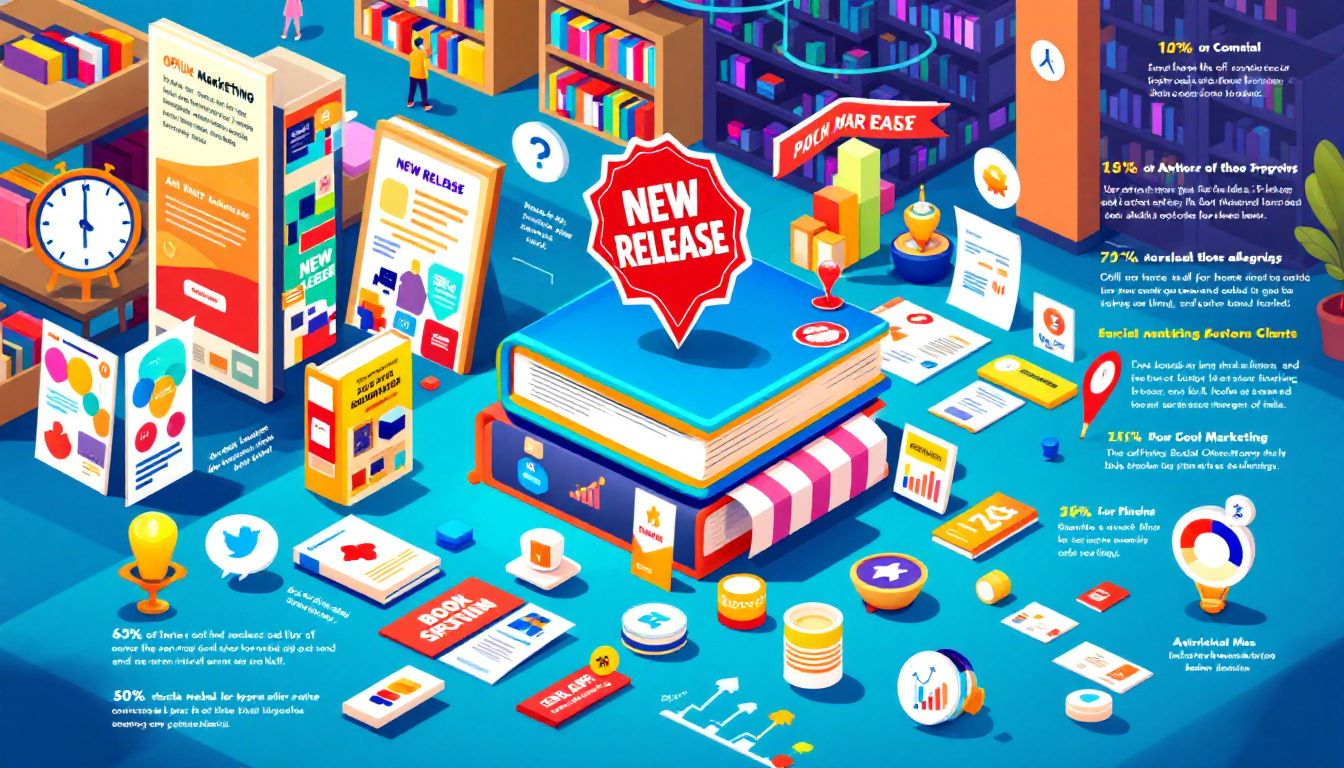How to Market A Self Published Book: Effective Strategies for Success
Feb 04, 2025
How to Market A Self Published Book: Top Tips and Strategies
Struggling to get your self-published book noticed? You’re not alone. Among the millions of books self-published last year, nearly all authors faced this challenge.
In this post, we’ll review practical strategies for marketing self-published books, from identifying your target readers to optimizing your online presence. With these book marketing tips, you will turn your hard work into sales.
Key Takeaways
-
Know your target audience and their experience to tailor your marketing strategies and engage effectively with potential readers.
-
Build a clear author brand with a consistent online presence and connect often with your audience.
-
Have a variety of marketing tactics, including social media, email campaigns, and collaborations with influencers, to enhance your book’s visibility and reach.
Define Your Target Audience
Understanding your target reader will save you time and money and will help you more effectively market your book. When a book resonates with its intended audience, there’s a greater chance it will be well-received and spread by word-of-mouth. Tailoring content and promotional tactics to align with the preferences of your ideal readers ensures that you are directly addressing those most likely to value your writing.
Jumping into communities associated with your book will help extend its reach among potential readers. These communities are amazing gathering places for readers who want to connect with others on similar topics. Observing what has worked for comparable titles that have found success can shed light on appealing aspects and impactful marketing approaches relevant to those interested in your work. Whether marketing a self-published, hybrid, or traditionally published book, the key is to understand and engage your reader authentically.
Be mindful not to overlook your secondary audience — specialized groups outside the primary target audience might become enthusiastic supporters of your material. Investigating social media interactions with established authors could reveal useful data about trends and interests related to your readers within these niche audiences. Seeking input from peers or experts in the field allows for finer adjustments when defining who precisely makes up your target market.
Set Your Goals
Setting clear goals provides a clear direction for any self-published author looking to market their book. Your goals are a roadmap for your marketing efforts, helping you stay focused, motivated, and knowing what marketing activities to implement. When setting your goals, consider the following:
-
What do you want to achieve with your book marketing efforts? Whether your aim is to increase book sales, build your author platform, or establish yourself as an expert, having a clear objective will guide the marketing activities that will be most effective.
-
Who is your target reader? Understanding your reader will help you tailor your marketing efforts to authentically connect and provide content that's relevant to the reader. Knowing their preferences and behaviors will significantly enhance your book marketing strategies.
-
What is your budget for marketing? Setting a budget will help you make smart decisions about where and how to use your marketing dollars. A budget provides guardrails on what marketing efforts will most likely provide the best results without overspending.
-
What is your timeline for marketing? Setting a timeline will help you stay on track and ensure that you’re making progress towards your goals. It also helps you to plan for key events like book launches and promotions.
By setting clear goals, you’ll create a highly focused marketing plan that helps you achieve self-publishing success.
Build an Author Brand
Your author brand is more than just a logo or a catchy tagline. Your brand represents your identity as an author. This includes your writing style, your website, and how you present yourself on social media.
Having an up-to-date professional website for yourself and your book is the cornerstone of your brand. It showcases crucial information such as the value you provide, your bio, a list of publications, and how to connect and engage with you across social networks. Maintaining uniformity in visuals like logos and typography across platforms shows a unified brand image and voice.
Cultivating a unique voice for your brand facilitates authenticity and helps retain uniform messaging throughout all forms of communication. Engaging with audiences through content they find relatable on social media platforms can significantly strengthen the relationship between readers and you.
Create a Professional Website
As a self-published author, having a professional website establishes your online presence and promotes your book. Your website should be easy to navigate, visually appealing, and provide a clear call-to-action for visitors.
Here are some key elements to include on your website:
-
A homepage that introduces you and your book: This is the first impression visitors will have, so make it engaging and informative.
-
A blog where you can share updates, insights, and behind-the-scenes information about your writing life: Consistent blog posts can keep your audience engaged and coming back for more.
-
An About The Book page: Have a summary of how your book will help those who visit your page. This is another touch point for readers to potentially purchase your book.
-
A contact us page: Provide a way for readers to reach out to you with questions or comments.
-
A newsletter sign-up form: Building an email list is essential for ongoing communication with your readers. Offering incentives like exclusive content or updates will encourage sign-ups.
A book we highly recommend to help craft your author brand and website is Donald Miller's bestselling book Building a StoryBrand 2.0: Clarify Your Message So Customers Will Listen. Check it out.
Optimize Your Book's Metadata
Enhancing the visibility of your book in search results can be achieved by optimizing its metadata. Essential components such as the title, subtitle, book description, series name, book categories, and keywords should be tailored for search engine optimization (SEO).
By being aware that this metadata needs to resonate with your audience, you increase the likelihood of higher click-through rates, which can lead to increased sales and engagement with readers. It’s important to keep this information up-to-date so it stays pertinent and continues to draw in new readers effectively.
However, there is an art and a science to metadata. Be sure that the information in your metadata makes sense, is relevant, and aligns with what your reader would realistically search for and engage with.
Create an Engaging Book Cover
The old saying that you can't judge a book by its cover is only partially true. A captivating book cover has the power to draw in potential readers, as it is frequently their first impression of you and your work. The attractiveness of your cover can influence both visibility and sales within the digital marketplace—most book covers are first seen on a screen as a thumbnail size—making the investment in a professional designer invaluable for optimizing your book’s aesthetic appeal and promotional capacity.
An impactful cover artfully blends visual allure with unambiguous signaling of what to expect from the text regarding its genre, tone, and central themes. Familiarity with genre conventions ensures that these cues resonate positively with reader anticipation aligning it with what unfolds within.
Using contrasting colors on your book cover not only improves its chances of catching someone's eye but also directs where you want the readers to focus such as the title and author’s name. Your name and the title need to prominently stand out.
Leverage Social Media Platforms
Utilizing social media platforms effectively can help forge strong connections with your target audience. To build and maintain strong engagement, it’s essential to focus on the platforms where your potential readers spend most of their time. Craft content that is both engaging and visually attractive, by including book previews, graphics, and interactive features such as quizzes and polls, you can more strongly resonate with your audience.
Motivate your readers to post about their experiences with your work and encourage them to write reviews on social media. Collaborating with influencers can expand your reach while also enhancing credibility among audiences. Take advantage of targeted advertising capabilities within these social networks which will allow you to connect directly with specific reader demographics. Have value-driven calls-to-action that link back to purchasing options for your book or signing up for a related newsletter or booking a speaking engagement.
Gather Positive Reviews
Positive feedback adds momentum to the promotion of books, playing a critical role in shaping prospective buyers’ perceptions and greatly affecting their decision to purchase. Motivating readers to post reviews by providing complimentary or advance reader copies (ARCs) can lead to increased sales and bolster credibility.
Soliciting reviews from personal contacts such as community members, family, friends, well-known bloggers, and colleagues within online writing communities is beneficial.
Email Marketing
Email marketing is a relevant and effective way to connect with your audience. Adding a signup link in your book’s back matter can help build an email list of your target audience. Lead magnets, like free book downloads, can entice readers to offer their contact information, ultimately boosting book sales.
As you build your email list you can share regular updates, exclusive content, and promotions with email subscribers to keep them engaged. Send marketing emails weekly to maintain engagement without overwhelming subscribers. Monitor open rates, click rates, and unsubscribe rates to assess the effectiveness of your email marketing campaigns.
Paid Advertising
Paying for ads can increase your number of potential readers at a faster rate. Consider running paid advertisements on services such as Facebook, Google, Pinterest, Amazon, and Goodreads. Make sure that these ads are tailored to the intended audience. Devote effort to experimenting with various formats to achieve improved outcomes. This is not a set-it-and-forget-it approach.
It is critical to your success to regularly check the return on investment (ROI) from your advertising efforts and critically scrutinize the outcomes. This practice will help you make informed modifications to improve your campaigns’ effectiveness.
Host Virtual and In-Person Events
Organizing both virtual and live events presents a fantastic opportunity to connect with potential readers while publicizing your publications. Consider hosting a virtual book tour to engage with a global audience through interactive sessions on platforms such as Zoom or Google Meet. Utilize webinars as an interactive medium that enables you to convey information directly to participants.
In-person events at schools or libraries create a personal interaction with attendees. Partnering with neighborhood bookstores or libraries can open doors to new and fresh audiences and facilitate memorable experiences. When aiming to draw attention to location-based events, targeted advertisements on digital platforms like Google or Facebook are highly effective tools for promotion.
Engage with Book Clubs and Libraries
Participating in book clubs relevant to your book is a high-touch point to connect with your audience. Being part of a book club offers valuable knowledge about what readers are looking for and the factors that influence their book-purchasing choices. Conducting a book launch presents an opportunity for authors to facilitate conversations and develop communities centered on their publications.
This may be a long-term book marketing tactic but you never know who you will meet and what it will lead to.
Create Compelling Book Trailers
Book trailers are excellent for capturing potential readers’ interest. Planning your trailer with a mini-script helps provide structure and saves time and cost. Developing and releasing book teasers well before the book release will build anticipation and provide opportunities for early engagement.
Including quotes from the book, reviews and endorsements, the author's/book's website link, and the book title will all help to engage the readers. Sharing book trailers across all digital marketing platforms enhances visibility. Investing in book trailers is a creative way to promote your books visually.
Offer Limited-Time Promotions
Limited-time promotions can boost your book marketing efforts by creating urgency to purchase. Seasonal discounts, anniversary sales, or special edition releases can attract readers. Book promotion strategies such as giveaways and contests create fun ways to engage your audience.
Short-term discounts create urgency, driving quicker sales as customers are encouraged to act fast. Combining limited-time offers with holidays or seasonal events can attract more attention due to heightened consumer activity.
Offering exclusive content or signed copies during promotions ads a special touch and can help tip someone over the edge who is looking to purchase your book.
Utilize Print Media and Offline Marketing
Despite the significance of digital marketing, the influence of print media and offline strategies in book marketing should not be overlooked. If your audience is likely to engage with those content mediums, placing ads in magazines and newspapers could speak directly to your audience. By collaborating with regional publications, you can amplify both your visibility and connect with more potential readers.
Incorporating tangible promotional items like bookmarks, postcards, and posters can add a memorable touch to your book promotion campaigns. If it makes sense and would add value to your audience, producing these types of printed materials when contemplating various book marketing ideas.
Expand Your Web Presence
Enhancing your online footprint will consistently add new readers to your author platform. Writing a guest post for blogs can expand your profile and allow you to interact with audiences who don't yet know about what you offer. Making appearances on well-known YouTube channels that align with the subject of your book can deepen your engagement and expand your reach to new audiences.
Create a Goodreads Strategy
Goodreads is a powerful platform for self-published authors, with over 150 million members and a vast collection of books. By creating a Goodreads strategy, you can increase your visibility, connect with readers, and drive sales in each launch phase. Here are some key elements to include in your Goodreads strategy:
-
Claim your author page and fill it out completely: Include a profile picture, bio, and list of your books to make your page inviting and informative.
-
Add your book to relevant lists and groups: Participate in genre-specific lists or groups for self-published authors to increase the book’s visibility.
-
Encourage readers to leave reviews and ratings for your book: Positive reviews can significantly impact your book’s credibility and attractiveness.
-
Participate in discussions and engage with readers: Join groups related to your genre and actively participate in discussions to build relationships with potential readers.
-
Run a Goodreads giveaway: This can generate buzz and increase visibility for your book, attracting new readers and reviews.
By creating a Goodreads strategy, you can tap into the vast community of readers on the platform and drive sales for your book.
Network with Other Self-Published Authors
Networking with other self-published authors is a wonderful way to build relationships, learn from others, and gain exposure for your book. Here are some ways to do that:
-
Join online communities and forums for self-published authors: Platforms such as Juxtabook Author Edge Community or the Alliance of Independent Authors offer valuable resources and networking opportunities.
-
Attend writing conferences and workshops: These events provide an opportunity to meet other authors and industry professionals in person, fostering valuable connections.
-
Participate in online events and webinars: Virtual book tours or author interviews allow you to go deeper into your content and showcase the value your book provides.
-
Collaborate with other authors on projects: Working together on anthologies or box sets can expand your reach and introduce you to new readers.
-
Share each other’s work on social media: Providing support and encouragement to fellow authors can build a supportive community and increase your visibility.
By networking with other self-published authors, you’ll be able to build a supportive community and gain exposure for your book.
Monitor Your Marketing Performance
Monitoring your marketing will set you apart from other authors. Tracking your results, you’ll be able to make informed decisions about how to adjust your marketing strategy and optimize your efforts. Here are some key metrics to track:
-
Website traffic and engagement: Monitor page views, bounce rate, and other engagement metrics to understand how visitors interact with your site.
-
Email open and click-through rates: Track these metrics to gauge the effectiveness of your email campaigns; to try out different hooks and topics to see what sticks.
-
Social media engagement metrics: Likes, shares, and comments can provide insights into how well your social media content is resonating with your audience.
-
Book sales and revenue metrics: Use Amazon Kindle Direct Publishing (KDP) reports and other sales data to track your book’s performance. In addition, utilizing Amazon Affiliate links can help show direct sales from specific marketing efforts.
-
Goodreads metrics: Monitor ratings and reviews to understand how readers are responding to your book.
By monitoring your marketing performance, you’ll be able to refine your strategy and make data-driven decisions to drive success for your book.
Summary
Marketing a self-published book requires several strategies tailored to your target audience: build a strong author brand, optimize your book’s metadata, and leverage both digital and offline marketing strategies. By being deliberate, you’ll be well on your way to driving forward your book’s visibility and sales.
Keep experimenting, stay consistent, and watch your readership grow!
Frequently Asked Questions
Why is defining my target audience so crucial?
Defining your target audience is crucial because it focuses your marketing on those most likely to buy your book, boosting your chances of success.
So, knowing who you’re trying to reach can really make a difference!
How can I effectively build my author brand?
To effectively build your author brand, focus on creating a professional website, ensuring consistency across all platforms, and developing a unique brand voice that reflects who you are as an author.
This will help you stand out and connect with your audience.
What elements should I focus on when optimizing my book's metadata?
To optimize your book’s metadata, focus on your title, subtitle, book description, and keywords.
Regular updates and a persuasive approach will help attract more readers.
How do book trailers help in book marketing?
Book trailers are a great way to grab potential readers’ attention and visually highlight what your book offers.
Sharing your book trailer on digital platforms boosts visibility and increases engagement.
What are some effective strategies for gathering positive reviews?
Encouraging readers to share their impressions by directly asking is a solid strategy for accumulating positive reviews. Consider offering a complimentary copy or an ARC (advance review copy) as an incentive. Encourage their authenticity and ask for honest and thoughtful reviews.
Employing automated platforms such as Booksprout can simplify this task and help increase the number of your reviews.
Stuck Knowing How to Publish Your Book?
Take the quiz to Discover the Ideal Book Publishing Path for You






